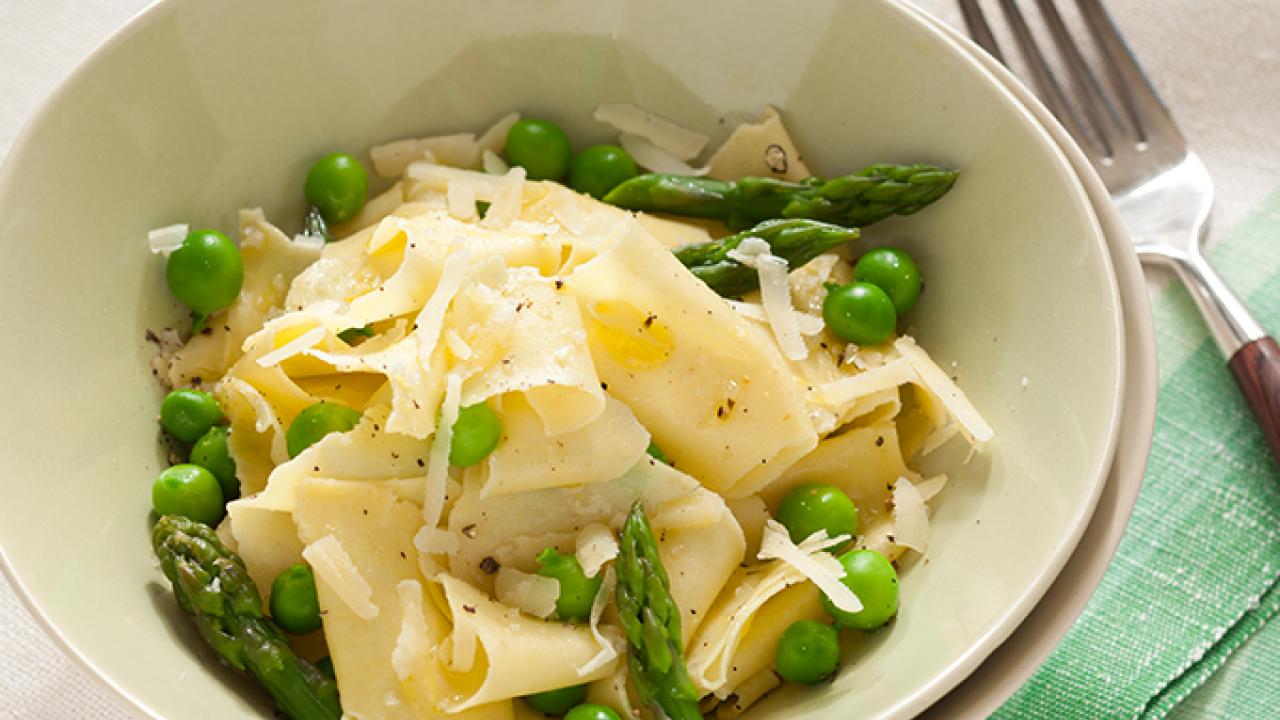
Recipe: Fresh Rag Pasta with Peas and Asparagus
lumna Ann Evans has updatedThe Davis Farmers Market Cookbook with 75 seasonal recipes. A portion of proceeds from her book sales will support the CA&ES Dean's Circle Scholarships Fund, a program that provides essential support to our students. The book is available at regional stores, online at ucdavisstores.com, and at the Davis Farmers Market. Below is a recipe for fresh rag pasta with peas and asparagus from the cookbook.
The dough for this main dish pasta is made in a food processor then rolled out into sheets by hand with the pasta attachment on a stand mixer or with a hand-cranked pasta machine. I use a stand mixer though I also have a pasta machine that Jonathan moon a contractor chef friend has taught me how to use for making ravioli the pasta sheets rolled by any one of the three methods can be cut into pappardelle, fettuccine, or lasagna, or they can be torn into pieces, as they are here. The delicate spring time sauce of tender peas and asparagus is a perfect match for the featherlight pasta. Zuckerman Family Farms, as well as a number of other vendors, brings beautiful fresh asparagus to the market each spring.
Pasta Dough
1 ½ to 2 cups all-purpose flour
1 teaspoon extra-virgin olive oil
2 eggs
Vegetables
1 pound asparagus
2 pounds English peas, shelled
To Finish
2 ½ teaspoons coarse sea or kosher salt
2 tablespoons extra-virgin olive oil or melted unsalted butter
¼ teaspoon freshly ground black pepper
2 tablespoons minced fresh flat-leaf parsley
¼ cup freshly grated Parmesan cheese
1. To make the pasta dough, in a food processor, combine 1 1/2 cups of the flour, the olive oil, and the eggs and process until soft crumbs form that can be pressed together into a ball. If it is too wet, add more flour, a little at a time. If it is too dry, add a little water. The dough should not be sticky.
2. Turn the dough out onto a lightly floured work surface and knead vigorously until smooth and satiny, about 7 minutes. Shape into a ball, cover with an overturned bowl, and let rest for 30 minutes.
3. Lightly flour a couple of large kitchen towels or baking sheets for holding the pasta sheets. Set up your pasta machine according to the manufacturer’s instructions. Set the rollers at the widest setting. Divide the ball of dough into balls the size of large walnuts. Slip all but 1 ball back under the bowl. Flatten the ball into a disk and turn the crank to pass it through the rollers. Repeat twice. Move the rollers to the next narrowest setting and again pass the dough through the rollers. Continue to pass the dough through the rollers, narrowing them each time, until you pass it through the next narrowest setting. Transfer the pasta sheet- it should be thin enough to see your hand through it- to a floured towel or baking sheet and repeat with the remaining pasta balls.
4. Alternatively, on a lightly floured work surface, roll out the pasta dough as thinly as possible and transfer to a floured towel or baking sheet. Again, when it is lifted, you should be able to see your hand through.
5. If you are not cooking the pasta right away, sprinkle the pasta sheets with flour and cover loosely with a towel. They will keep for up to 1 hour. Just before you are ready to cook the pasta, tear the sheets into 1 1/2 - to 2-inch pieces to make the "rags."
6. To prepare the vegetables, bend each asparagus spear near its base until it snaps. Discard the fibrous bases and trim the snapped ends on the diagonal. Slice the tenders spears on the diagonal into 1/2- inch pieces.
7. Fill a large pot three-fourths full of water and bring to a boil over high heat. Add the asparagus and cook until tender to a fork but still bright green, about 2 minutes. Using a slotted spoon or wire skimmer, remove the asparagus and rinse them under cold running water to halt the cooking. Drain well, pat dry, and set aside. Add the peas to the boiling water and cook for 30 seconds. Using the slotted spoon or skimmer, remove the peas from the water and rinse under cold running water to halt the cooking. Drain well, pat dry, and set aside.
8. To finish, if the water is not still at a rolling boil, return it to a boil over high heat. Add 1 1/2 teaspoons of the salt and half of the pasta pieces, stir well, reduce the heat to medium-high, and cook until tender, about 2 minutes. Using the slotted spoon or skimmer, lift the pasta from the water, allowing it to drain well, and place on a platter. Repeat with the remaining pasta. (If your pot is not large, you will need to cook the pasta in three or more batches.) Drizzle the pasta with 1 tablespoon of the olive oil and toss to coat evenly. Keep warm.
9. In a frying pan over medium heat, heat the remaining 1 tablespoon olive oil. When it is hot, add the asparagus, peas, the remaining 1 teaspoon salt, and the pepper and stir for about 30 seconds, just to warm the vegetables through.
10. Divide the past among warmed individual plates. Top each portion with one-fourth of the vegetables and sprinkle with the parsley and Parmesan cheese, dividing them evenly and tucking a few vegetables among the ragged pasta pieces. Serve at once.
Serves 4